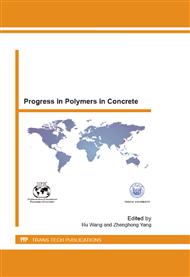p.255
p.262
p.266
p.274
p.282
p.291
p.298
p.303
p.311
Evaluation of Rut Resistance of Polymer-Modified Asphalt Concretes
Abstract:
The rutting is a significant damage mechanism showing longitudinal furrows along with both wheel paths on asphalt pavement surface. To prevent the rutting under heavy traffic condition, polymer-modified asphalt (PMA) concretes were introduced in asphalt pavement industry. To measure rut resistance of asphalt concretes, the asphalt pavement analyzer (APA) and the deformation strength, SD, were used in this study. The SD was measured by Kim Test, a simple static-loading test, on the 150 mm-diameter cylindrical specimens at 60oC and APA test was performed for the same material. The PMA concretes were found to show improvement in SD and APA rut resistance by more than 50% and 60%, respectively. The SD and APA rut depth showed a relatively high correlation (R2 = 0.81) each other at 60°C. Therefore, it was possible to estimate rut tendency of normal asphalt and polymer-modified asphalt concretes by SD.
Info:
Periodical:
Pages:
282-288
Citation:
Online since:
April 2013
Authors:
Keywords:
Price:
Сopyright:
© 2013 Trans Tech Publications Ltd. All Rights Reserved
Share:
Citation:


